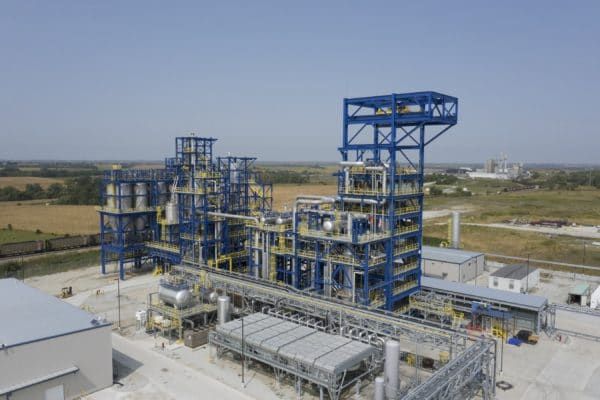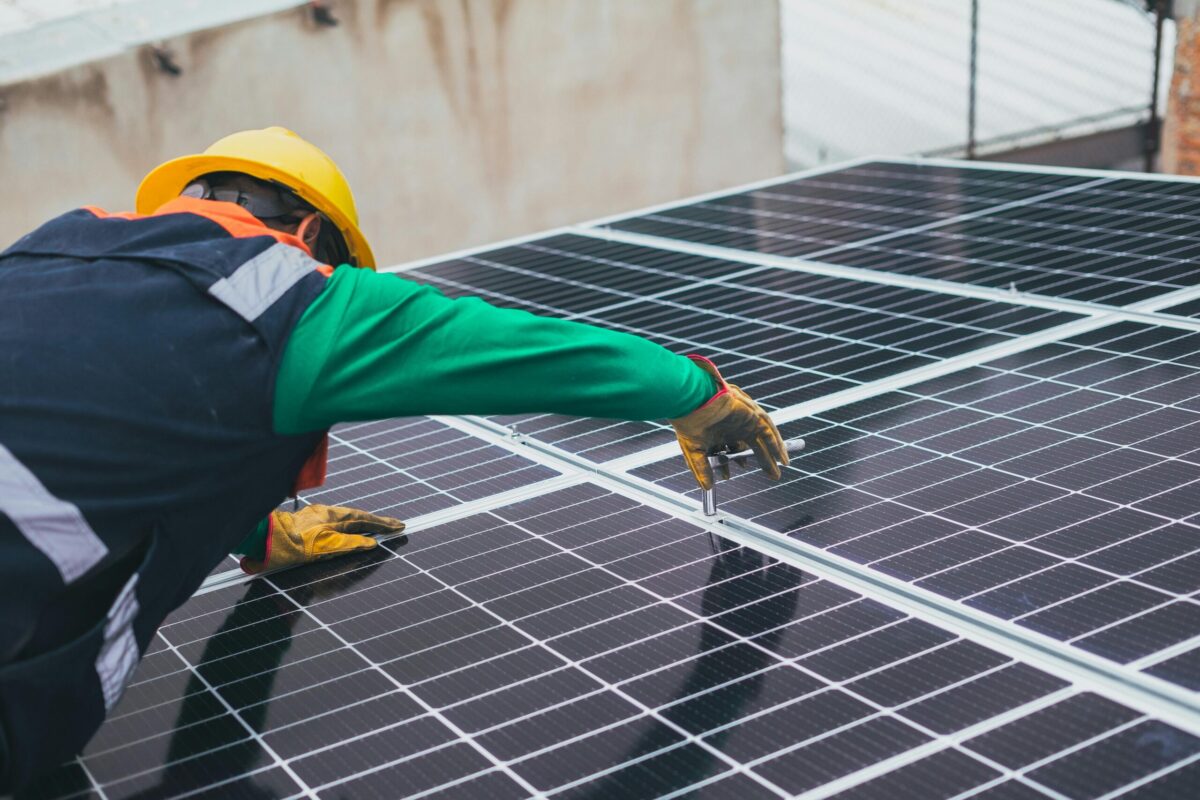Nebraska Public Power District (NPPD) signed a letter-of-intent with Monolith Materials to procure enough renewable energy resources to generate 2 million MWh annually for a carbon black production facility. NPPD will secure the generation resources and power will be delivered by Norris Public Power District, a wholesale customer of NPPD.
Olive Creek 1 (OC1) in Hallam, Nebraska, is Monolith Materials’ $100 million commercial-scale emissions-free production facility. It currently uses renewable energy credits to offset its electricity consumption.

Image: Monolith Materials
“The sustainability of our power supply is a critical factor for Monolith,” said Rob Hanson, co-founder and CEO. He said that while affordability and reliability are key business considerations, sustainability of the facility’s power supply is also critical.
Monolith converts natural gas to carbon black and hydrogen for use in products for the automotive, industrial and agricultural sectors.
NPPD President and CEO Tom Kent said NPPD will solicit bids through a request for proposals (RFP) for new wind or solar generation, including energy storage, through a Power Purchase Agreement (PPA).
NPPD said it expects to enter into PPAs by Sept. 1, with commercial operations expected to begin no later than Dec. 31, 2025. NPPD plans to issue the RFP in March. A shortlist will be developed for further negotiations.
Monolith is backed by Azimuth Capital Management, Cornell Capital LLC, Imperative Ventures and Warburg Pincus.
ReneSola signs MOU for European expansion
Solar developer ReneSola Ltd signed a Memorandum of Understanding with Eiffel Investment Group, an asset management firm with 3 billion euros under management, to form a joint venture to finance ReneSola Power’s current and future solar projects across Europe.
Under terms of the MOU, ReneSola Power and Eiffel will create a joint venture company with ReneSola holding a 51% ownership stake and Eiffel injecting capital for a 49% stake. The JV intends to develop up to 1 GW of solar projects in the next several years across Europe.
Eiffel will contribute to the joint venture as qualifying projects are built in targeted markets. ReneSola Power will lead the project identification and development process. Once built, the projects will be sold by the joint venture.
Connecticut-based ReneSola Power pursues development opportunities in the U.S. and Europe, including Poland, Hungary, Minnesota and New York. In December, ReneSola Ltd was awarded 38 solar utility projects in Poland, each with a capacity of 1 MW. The projects are expected to be connected to the grid within the next two years.
Canadian Solar sells project share
Canadian Solar Inc. sold an ownership interest in its Hays and Jenner solar projects to BluEarth Renewables, which will also assume management responsibilities of the projects. Located in southeast Alberta, both projects are 31 MWp (23 MWAC) in size. The projects are co-owned by Conklin Métis Local 193, an indigenous community. Both projects are expected to start commercial operation this year. Terms of the sale were not disclosed.
The Hays and Jenner solar projects will use Canadian Solar’s bifacial modules and single-axis trackers, further commercializing this technology in Canada after being first deployed on Canadian Solar’s Suffield Solar Project, which is now owned by BluEarth.
Battery-electric locomotive begins testing
BNSF Railway Company and Wabtec began testing a battery-electric locomotive in revenue service on a 350-mile run between Barstow and Stockton, California.
The lithium-ion battery equipped locomotive will be placed between two Tier 4 locomotives, creating a battery-electric hybrid “consist.” When running on the mainline, both the battery-electric and diesel locomotives will power the train.
The battery-electric locomotive is expected to improve fuel economy for the entire consist by at least 10%. The pilot test will run from January until the end of March. If the initial pilot proves successful, BNSF said it will look to expand testing to other locations and operating conditions on its system.
BNSF partnered with Wabtec to develop the battery-electric locomotive. An energy-management system, including onboard energy storage that, when coupled with system-optimization controls, is designed to improve consist and train performance.
(Watch Wabtec’s video to see how the technology works.)
The locomotive can generate up to 4,400 hp and deliver 2,400 kWh of storage capacity. On board are roughly 20,000 lithium-ion batteries. The batteries can be recharged either through a wayside charging station at Stockton or via regenerative braking, similar to an electric vehicle.
The battery-electric locomotive pilot program is part of a $22.6 million grant awarded to BNSF and the San Joaquin Valley Air Pollution Control District from the Zero- and Near Zero-Emission Freight Facilities (ZANZEFF) project by the California Air Resource Board to pilot several emissions-reducing technologies in and around railyards. The ZANZEFF project is part of California Climate Investments, an initiative that uses money generated by the state’s Cap-and-Trade program.
After a bad 2020, natural gas is recovering
The Dallas Federal Reserve branch bank said in a brief that natural gas future prices fell to a historic low in June 2020 but rebounded by late October, with prices more than doubling to $3 per million British thermal units (MMBtu).
Total natural gas production reached 104.3 billion cubic feet per day (bcf/d) in December 2019. That was up from nearly 60 bcf/d a decade earlier.
The brief said that surging gas production over the past decade drove a boom in pipeline gas exports to Mexico and Canada. Production growth also lifted exports of liquefied natural gas, which peaked near 7.9 bcf/d in March 2020.
Natural gas production also trimmed energy and materials costs for the petrochemicals industry and other domestic users, and helped reduce U.S. carbon dioxide emissions by displacing coal from the mix of fuels used to generate electricity. In 2019, renewable resource energy consumption surpassed coal for the first time in more than 130 years. Electric utilities continue to switch from natural gas to coal to generate electricity depending on the commodity price. Demand for both fossil fuels last year was dampened by reduced electricity demand due to the pandemic.
The Henry Hub natural gas price, considered the U.S. benchmark, averaged $2.56 per MMBtu in 2019 as new supplies swamped demand, the Dallas Fed said. A mild 2019–20 winter left domestic natural gas inventories near a three-year high in February 2020.
Henry Hub natural gas reached an inflation-adjusted historic low average price of $1.60 per MMBtu in June, the Dallas Fed said. U.S. oil producers shut in crude production as spare storage capacity for unwanted crude evaporated.
Output began to return in June when shut-in wells began to be turned back on. That process was largely completed by late summer. Gas produced from oil-focused shale basins fell from 40.6 bcf/d before the pandemic to 37.4 bcf/d in October.
With the winter heating season approaching and expected lower U.S. gas production, natural gas futures rose above $3 per MMBtu at the end of October, still below preshale levels. The Dallas Fed said that subsequent gas price drops in early December—following upticks in oil well completions and oil price futures—signal that U.S. natural gas is inversely tied to expected shale oil output, at least for now.
This content is protected by copyright and may not be reused. If you want to cooperate with us and would like to reuse some of our content, please contact: editors@pv-magazine.com.









By submitting this form you agree to pv magazine using your data for the purposes of publishing your comment.
Your personal data will only be disclosed or otherwise transmitted to third parties for the purposes of spam filtering or if this is necessary for technical maintenance of the website. Any other transfer to third parties will not take place unless this is justified on the basis of applicable data protection regulations or if pv magazine is legally obliged to do so.
You may revoke this consent at any time with effect for the future, in which case your personal data will be deleted immediately. Otherwise, your data will be deleted if pv magazine has processed your request or the purpose of data storage is fulfilled.
Further information on data privacy can be found in our Data Protection Policy.